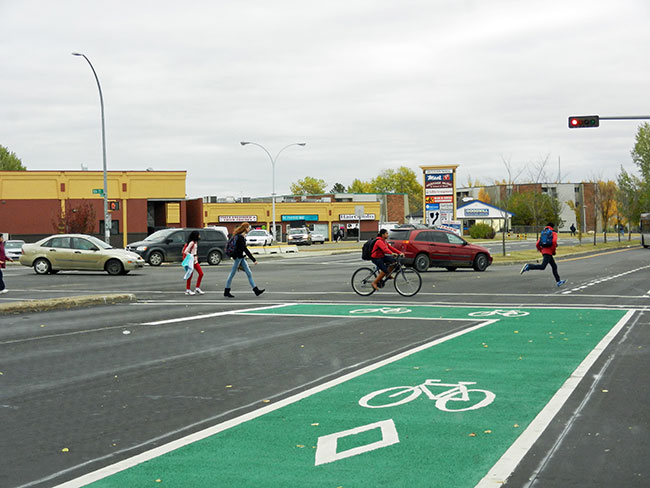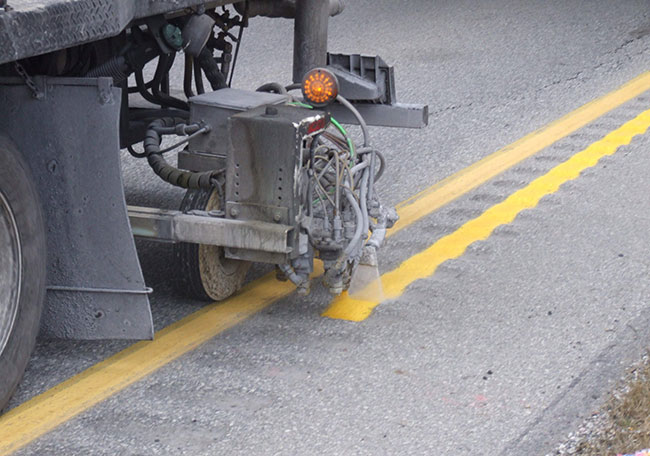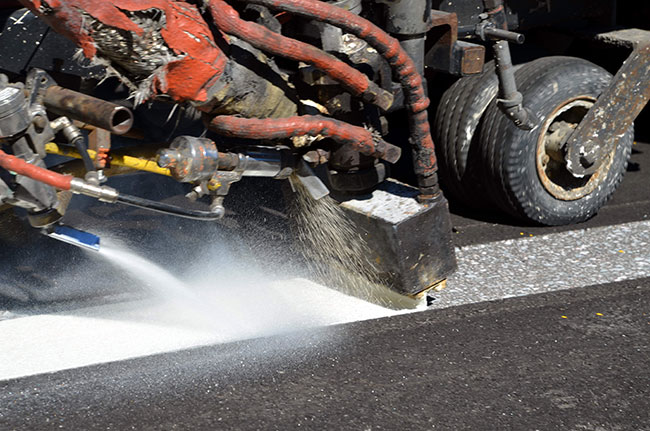
Features
Roads & Paving
Technology
Marking the road ahead
New innovations in road marking technology
April 17, 2015 By Treena Hein
Which markings end up on our roads is a matter of achieving a balance between performance and cost.
Which markings end up on our roads is a matter of achieving a balance between performance and cost. It’s a well-known fact that poorly-maintained pavement markings are a safety hazard. But how much maintenance (re-striping of centre and shoulder lines) is needed depends on the durability of the marking itself – and that’s why reliable up-to-date information about various materials, and things like how inlaid markings perform in comparison to paint and more, matters so much.
 |
|
| Markings are becoming critically important for the safety of cyclists and pedestrians on major roadways.
|
The costs of having roads with markings that stand up in all weather conditions depend on both the maintenance needed and the initial cost. (The markings on some high-traffic roads for example, require no maintenance because their very high durability lasts the lifetime of the pavement, but they cost much more up front.) In order to cost-effectively manage this country’s road markings, the various government authorities and private companies responsible need to create strategic plans that take all factors into account. To get a sense of what affects the performance of various markings now in use, what’s coming down the pipe and what’s needed in the future, read on.
Paint
The most common road marking method in North America is paint. Paint costs significantly less than any other marking method, but can be quickly worn away on roads with high traffic volumes, which means re-striping may be needed more than once a year. Both solvent-based alkyd paints and waterborne latex paints are in use, with water-based paint being the cheapest option. Tim Zapf is a marketing manager at Lafrentz Road Marking (a division of Canadian Road Builders Inc., with offices in several western Canadian provinces). He notes that Environment Canada adopted legislation over the last few years requiring the use of more low-VOC (volatile organic compound) paint – and latex falls in that category – so its use is increasing. Zapf says these new paints also present challenges in application. In addition, “with the switch from alkyd (oil-based) paint to environmentally-responsible low-VOC alternatives,” he explains, “we have seen the quality and durability of painted roadway markings drop.”

|
|
| Rumble strips are proven countermeasures for lane departure safety, and painted strips are improving safety even more.
|
Epoxy pavement markings are one of several options that are significantly more expensive than paint, but which offer longer service life on roads with even high traffic volumes, and also offer higher “retro reflectivity” levels compared to paint. If retro reflectivity is low, the marking is harder to see at night and in wet weather, and Zapf points out that brighter lines are definitely in demand with the growing number of aging drivers on our roads. Over the last few years, the Ontario Ministry of Transportation (MTO) has been testing different pavement marking materials on highways to provide better visibility. “Examples include reflective tape, embedded pavement markers, paint with larger glass beads recessed into the pavement and textured plastic paints,” says Bob Nichols, MTO senior media officer. “The intent with all these products is to find a better way to protect the glass beads from snowplows and provide improved visibility and better reflective qualities during wet weather.”
Tarek Zayed believes that over the coming decade, the use of epoxy, thermoplastic tape and MMA (methyl methacrylate) will become cheaper and their use will increase, but how they fare in harsh conditions must be studied. Zayed, who is a professor in the department of building, civil and environmental engineering at Concordia University in Montreal, attended the annual U.S. Transportation Research Board conference in January 2015. Anything and everything to do with road markings is presented there, but Zayed notes that there was not much new on the materials front. He does not believe we’ll see many new materials being introduced in the near future.
Models for maintenance
From 2006 to 2009 (when funding ended), Zayed spearheaded a project with the aim of developing performance models that predict the state of different marking materials under different conditions. In all, the effect of eleven factors on alkyd paint were examined, including annual average daily traffic, pavement surface condition, traffic speed, salt use and snow removal. The models Zayed developed had an average validity range of 87 to 99 per cent, and they were made available to academics and road maintenance decision-makers across Canada to help them prioritize inspection, painting and re-painting tasks, but Zayed is not sure how much they were used or are still in use.
The MTO has implemented a performance-based specification for pavement markings in maintenance re-striping applications. It includes minimum durability and retro reflectivity requirements that must be maintained at all times. “The specification allows the applicator to choose the type of material, when to apply the markings and how to apply them to meet the minimum performance requirements,” Nichols explains. The types of material and markings that can be used include waterborne paint, epoxy, thermoplastic and embedded reflective materials, MMA and preformed tape, as well as other marking methods such as inlaid, “rumble strips” and profile markings (bumps). Because there have been some adhesion issues with some of the new innovative marking materials on freshly-applied asphalt, MTO will be implementing a specification for new construction work.
Inlays and colour
Inlaid line markings involve paint or other materials being applied into line-width areas where a small amount of asphalt has been ground away. The materials are therefore better protected in comparison to those applied to regular road surface. Neal Hawkins, director at the Center for Transportation Research and Education at Iowa State University, says that in regions of North America with snow plow use, inlaid markings certainly increase marking durability. Inlays can also provide significant cost savings. Hawkins points to a recent U.S. study where inlaid marks provided 17 per cent savings over three years compared to markings on normal pavement; 34 per cent savings were achieved if four years of acceptable marking performance was realized. “There continues to be a wide variation in depth and width of inlay, with deeper grooves providing more room to protect the markings from snow plow blades and to allow for paint reapplications,” he notes.
 |
|
| Markings that can withstand the elements improve delivery costs and the safety of our roadways.
|
Nichols says that in a few small MTO trials, inlaid markings “extend the expected maintenance interval by two to three times and are highly resistant to damage from snowplow blades. While performance has been good, inlays are not becoming more common in Ontario at the present because in general, road construction companies do not have the necessary equipment. Zapf believes Canada has generally been lagging behind Europe in the use of colour and different application processes like inlaid markings, but says he is seeing an increase in the use of durable materials over paint in the municipal market to achieve year-round delineation with good retro reflectivity.
Another marking development is colour. Zapf says that because many Canadian municipalities are encouraging different modes of active transportation such as walking and cycling, there will be much more need for safe walkways, multi-use pathways and dedicated bicycle routes. “Wherever these co-exist or intersect with vehicles, markings become critically important,” Zapf says. “Coloured surfaces with clear delineation, and good information about how the different modes of transportation are to interact, will be crucial.” Nichols says MTO does not currently have any enhanced safety markings projects that involve custom design and colours.
Rumble strips and more
Hawkins notes that centre and shoulder rumble strips are proven lane departure safety countermeasures, and because their effectiveness is well established, the use of rumble strips continues to increase. “[They] reduce all injury collisions by a statistically-significant 18 per cent,” he says. “Shoulder rumble strips have been shown to reduce off-road right collisions by a statistically-significant 22 per cent with centerline rumble strips reducing off-road left and head-on collisions by… 29 per cent.”
Hawkins also “marks” an exciting growth area in the use of high-friction surfaces, especially on curves and ramps, to help further address and mitigate lane departure crashes. Nichols says these are generally composed of an epoxy or MMA-based marking material with a skid-resistant aggregate. MTO has had a few internal discussions on potential applications, but has not yet found a suitable site for study.
Going forward, Zayed would like to see more study of different paint markings in the Canadian environment. “It’s really worth it for safety to study this,” he notes. “No one to my knowledge in Canada has studied the effect of salt and snow removal on reflectivity for example. In the U.S. they’ve done a lot of work on this and have created standards in many U.S. states. Having the technology to objectively measure how much reflectivity older markings still provide would really help in developing standards here and improving decision-making.”
Print this page